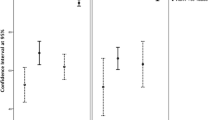Abstract
Background and aims
Two theories have been reported for the pathophysiology of levator ani syndrome: the spastic cycle hypothesis and the local inflammation (Tendinitis) hypothesis. This study compared two treatment modalities in order to determine which of the two hypotheses is more appropriate.
Subjects and methods
In this prospective study, Group EGS (n=22) underwent electrogalvanic stimulation twice a week. Group LI (n=31) underwent a local injection of a 40-mg triamcinolone acetonide mix with 1 ml 2% lidocaine into the maximal tender point of the arcus tendon in the levator ani muscle.
Results
The most common location of tenderness was the left anterior of the arcus tendon of the levator ani muscle. At the last follow-up (12 months), the LI group showed more relief, more improvement, and fewer failures than the EGS group. No difference was seen between the mean pain scores (verbal analog scale: 0–100) of the two groups at either the 1-week or the 12-month follow-up. However, the LI group showed better results at the 1-month, 3-month, and 6-month follow-ups.
Conclusion
The LI group showed better short-term results than the EGS group. Therefore, the tendinitis hypothesis seems to be the more reliable one for levator ani syndrome. However, because the subjective responses of the patients indicated that a sufficient level of patient satisfaction had not been achieved, we cannot positively conclude that the tendinitis hypothesis is the more reliable one for the pathophysiology of levator ani syndrome.
Similar content being viewed by others
References
Whitehead WE, Wald A, Diamant NE, Enck P, Pemberton JH, Rao SSC (1999) Functional disorders of the anus and rectum. Gut 45 [Suppl 2]:1155–1159
Grant SR, Salvati EP, Rubin RJ (1975) Levator syndrome: an analysis of 316 cases. Dis Colon Rectum 18:161–163
Grimaud JC, Bouvier M, Naudy B, Guien C, Salducci J (1991) Manometric and radiologic investigations and biofeedback treatment of chronic idiopathic anal pain. Dis Colon Rectum 34:690–695
Kang YS, Jeong SY, Cho HJ, Kim DS, Lee DH, Kim TS (2000) Transanally injected triamcinolone acetonide in levator syndrome. Dis Colon Rectum 43:1288–1291
Heymen S, Wexner SD, Gulledge AD (1993) MMPI assessment of patients with functional bowel disorders. Dis Colon Rectum 36:593–596
Thiele GH (1963) Coccygodynia: cause and treatment. Dis Colon Rectum 6:422–426
Smith WT (1959) Levator spasm syndrome. Minn Med 43:1076–1079
Sohn N, Weinstein MA, Robbins RD (1982) The levator syndrome and its treatment with high-voltage electrogalvanic stimulations. Am J Surg 144:580–582
Nicosia JF, Abcarian H (1985) Levator syndrome: a treatment that works. Dis Colon Rectum 28:406–408
Oliver GC, Rubin RJ, Salvati EP et al (1985) Electrogalvanic stimulation in the treatment of levator syndrome. Dis Colon Rectum 28:662–663
Billingham RP, Isler JT, Friend WG, Hostetler J (1987) Treatment of levator syndrome using high-voltage electrogalvanic stimulation. Dis Colon Rectum 30:584–587
Hull TL, Milsom JW, Church J, Oakley J, Lavery I, Fazio V (1993) Electrogalvanic stimulation for levator syndrome: how effective is it in the long term? Dis Colon Rectum 36:731–733
Grant SR, Salvati EP, Rubin RJ (1975) Levator syndrome: an analysis of 316 cases. Dis Colon Rectum 18:161–163
Gilliland R, Heymen JS, Altomare DF, Vickers D, Wexner SD (1997) Biofeedback for intractable rectal pain: outcome and predictors of success. Dis Colon Rectum 40:190–196
Ger GC, Wexner SD, Jorge JMN et al (1993) Evaluation and treatment of chronic intractable rectal pain: a frustrating endeavor. Dis Colon Rectum 36:139–145
Heah S-M, Ho Y-H, Tan M, Leong A (1997) Biofeedback is effective treatment for levator ani syndrome. Dis Colon Rectum 40:187–189
Acknowledgments
We thank Prof. Edward J. Button, PhD, for his assistance in the preparation of this manuscript. This research was presented at the 34th meeting of the Korean Society of Coloproctology, Jeju island, Korea, March 29–30, 2002.
Author information
Authors and Affiliations
Corresponding author
Rights and permissions
About this article
Cite this article
Park, DH., Yoon, SG., Kim, K.U. et al. Comparison study between electrogalvanic stimulation and local injection therapy in levator ani syndrome. Int J Colorectal Dis 20, 272–276 (2005). https://doi.org/10.1007/s00384-004-0662-9
Accepted:
Published:
Issue Date:
DOI: https://doi.org/10.1007/s00384-004-0662-9




